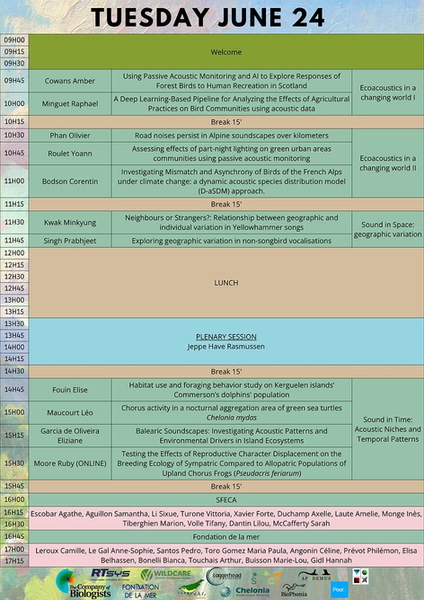
JJBA 2025 | June 24-26, 2025
Young Bioacousticians Days 2025 – Event Summary
The 3rd edition of the Young Bioacousticians Days (JJBA 2025) was held from June 24 to 26, 2025 in Vernon, France , and was a great success. The event brought together around 70 participants from 12 countries and 3 continents, including students, young researchers and professionals from academia and the private sector.
Over three days, participants were able to share their work and exchange ideas through 30 oral presentations, 23 posters and 9 scientific sessions. The program also included 3 plenary conferences – two led by established researchers and one by an innovative company in the field of bioacoustics – as well as 2 interactive workshops:
-
AI and Bioacoustics: An Introduction to Artificial Intelligence and Its Applications.
-
Applied bioacoustics: demonstrations of sound localization and presentation of equipment.
To make the conference accessible to all, registration fees were kept to a minimum, and accommodation and meals were provided to all participants presenting their work. Most sessions were streamed live on YouTube, with approximately 100 viewers per day. The conference provided an open and friendly environment, fostering learning, collaboration, and exchange among young bioacousticians. Following this success, a new edition is already in preparation for next year.
JJBA 2025
All the oral presentations were broadcast live on the JJBA Youtube channel.
Oral communications
Oral communications of 15 minutes are divided into different scientific sessions. Participants whose abstract has been accepted by the organizing committee will have the opportunity to present their recent scientific results.
Poster session
To introduce the session, each participant will start with a poster presentation (2 minutes per poster).
Plenary Conferences
Three plenary conferences of 45 minutes (+15 minutes of questions) will be held by experienced bioacousticians. These conferences will provide a unique opportunity for students and young researchers to attend presentation of major works in their field and exchange with established researchers.




Invited Speakers

Jeppe Have Rasmussen
Postdoc, University of Copenhagen
From Clicks to Moans: How Bioacoustics Keep Me Guessing Which Species I'm Studying Today

Michelle Spierings
Assistant professor Leiden University
The Biological Basis of Musicality: A Comparison Between Primates, Songbirds, and Parrots.

Corentin Troussard
Science & Industry Sales Manager RTSYS
Underwater Acoustics in the Age of AI and Robotics: Toward Permanent Ocean Surveillance.
Workshops
Applied bioacoustics
Michael Maggs, Frontier Labs
Andy Hill, Open Acoustic Devices
AI and bioacoustics
Jeppe Have Rasmussen, University of Copenhagen
General assembly
A general assembly will be helded on Friday, June 28 to discuss the future of the colloquium and ensure its sustainability. The objective of this general assembly is to present the colloquium project as a whole, to discuss the points to be improved based on the previous editions and to recruit volunteers to support the organization of next editions.
Social events
Regular breaks will punctuate the conference to promote scientific exchanges. A dinner of local specialties and a gala dinner will also be organized in order to create links between the participants. The transdisciplinarity being at the heart of this symposium project, the objective is to facilitate exchanges between scientists from different backgrounds in a friendly, enthusiastic and productive atmosphere.
Organizing team



Patrick KAGERER
Marianne SARFATI
Justine GIRARDET
President
University of Iceland
Vice-President
Royal Holloway University of London
Treasurer
University of Toulon, LIS Laboratory,
CIAN, France and University of Pavia, Italy



Loanne PICHOT
Salomé MARIN-MARIN
Lucie JEAN-LABADYE
Secretary
UMRAE, Gustave Eiffel University
- CEREMA, Rouen
Member of the organizing committee
CEREMA, Rouen
Member of the organizing committee
Sorbonne University

April HOUWELING

Loréna BOISSEAU
Member of the organizing committee
Simon Fraser University
Member of the organizing committee
Estación Biológica de Doñana- CSIC, Seville, Spain
















